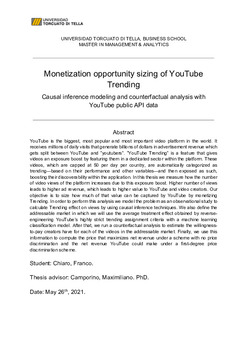| dc.rights.license | https://creativecommons.org/licenses/by-sa/2.5/ar/ | es_AR |
| dc.contributor.advisor | Camporino, Maximiliano | es_Ar |
| dc.contributor.author | Chiaro, Franco | es_AR |
| dc.date.accessioned | 2022-08-26T22:49:21Z | |
| dc.date.available | 2022-08-26T22:49:21Z | |
| dc.date.issued | 2021 | |
| dc.identifier.uri | https://repositorio.utdt.edu/handle/20.500.13098/11278 | |
| dc.description.abstract | YouTube es la plataforma de vídeos más grande, popular e importante del mundo. Recibe
millones de visitas diarias que generan miles de millones de dólares en ingresos publicitarios
que se dividen entre YouTube y los "youtubers". “YouTube Trending” es una función que
aumenta la exposición de los vídeos al presentarlos en un sector específico dentro de la
plataforma. Estos vídeos, que tienen un límite de 50 por día, por país, son categorizados
automáticamente como tendencias—según su rendimiento y otras variables—y luego
expuestos como tales, aumentando su visibilidad dentro de la aplicación. En esta tesis
medimos cómo aumenta la cantidad de vistas de videos de la plataforma debido a este
incremento de exposición. Una mayor cantidad de vistas implica mayores ingresos
publicitarios, lo que implica un mayor valor para YouTube y para los creadores de videos.
Nuestro objetivo es medir cuánto de ese valor puede ser capturado por YouTube monetizando
Trending. Para realizar este análisis, modelamos el problema como un estudio observacional
para calcular el efecto de tendencia en las vistas de vídeos utilizando técnicas de inferencia
causal. También definimos el mercado direccionable en el que utilizaremos el efecto promedio
de tratamiento obtenido, haciendo ingeniería inversa sobre el criterio de asignación de
tendencias altamente estricto que utiliza YouTube con un modelo de clasificación de
aprendizaje automático. Después de eso, realizamos un análisis contrafáctico para estimar la
disposición a pagar que tienen los creadores para cada uno de los videos en el mercado
direccionable. Finalmente, usamos esta información para calcular el precio que maximiza los
ingresos netos bajo un esquema de precios sin discriminación y los ingresos netos que
YouTube podría generar bajo un esquema de precios con discriminación de primer grado. | es_AR |
| dc.description.abstract | YouTube is the biggest, most popular and most important video platform in the world. It
receives millions of daily visits that generate billions of dollars in advertisement revenue which
gets split between YouTube and “youtubers”. “YouTube Trending” is a feature that gives
videos an exposure boost by featuring them in a dedicated sector within the platform. These
videos, which are capped at 50 per day per country, are automatically categorized as
trending—based on their performance and other variables—and then exposed as such,
boosting their discoverability within the application. In this thesis we measure how the number
of video views of the platform increases due to this exposure boost. Higher number of views
leads to higher ad revenue, which leads to higher value to YouTube and video creators. Our
objective is to size how much of that value can be captured by YouTube by monetizing
Trending. In order to perform this analysis we model the problem as an observational study to
calculate Trending effect on views by using causal inference techniques. We also define the
addressable market in which we will use the average treatment effect obtained by reverseengineering
YouTube’s highly strict trending assignment criteria with a machine learning
classification model. After that, we run a counterfactual analysis to estimate the willingnessto-
pay creators have for each of the videos in the addressable market. Finally, we use this
information to compute the price that maximizes net revenue under a scheme with no price
discrimination and the net revenue YouTube could make under a first-degree price
discrimination scheme. | es_AR |
| dc.format.extent | 65 p. | es_AR |
| dc.format.medium | application/pdf | es_AR |
| dc.language | spa | es_AR |
| dc.rights | info:eu-repo/semantics/openAccess | es_AR |
| dc.subject | Redes Sociales (en línea) | es_AR |
| dc.subject | Videos | es_AR |
| dc.subject | Marketing | es_AR |
| dc.subject | Publicidad Audiovisual | es_AR |
| dc.subject | Entretenimiento | es_AR |
| dc.title | Monetization opportunity sizing of YouTube Trending: Causal inference modeling and counterfactual analysis with YouTube public API data | es_AR |
| dc.type | info:eu-repo/semantics/masterThesis | es_AR |
| dcterms.description.tableOfContents | 1. Introduction 4; 1.1 YouTube Advertisement 4; 1.2 YouTube Trending 5; 1.3 The business case 7; 1.4 Methodology 8; 1.4.1 Trending effect estimation 9; 1.4.2 Addressable market definition 9; 1.4.3 Willingness-to-pay calculation 9; 1.4.4 Optimal price calculation 9; 2. The data 10; 2.1 Dataset setup 10; 2.2.1 Dataset structure 10; 2.2.2 Dataset construction 13; 2.2.3 Feature engineering 14; 2.1 Descriptive analysis 15; 3. Trending effect estimation: causal inference analysis 21; 3.1 Naive estimation 22; 3.2 Multivariable Linear Regression 26; 3.2.1 Linear-linear regression 27; 3.2.2 Log-log regression 29; 3.2.3 Flaws of OLS regression models 30; 3.3 Propensity Score & Matching 31; 3.3.1 Propensity Score Matching 31; 3.3.2 Propensity Score Weighting 33; 3.3.3 Doubly Robust Weighted Estimator 35; 3.4 ATE interpretation, usage and hypothesis validation 39; 3.3.1 Interpreting and using ATE 39; 3.3.2 Hypothesis validation 41; 3.5 Inference model validation 43; 4. Addressable market definition 45; 4.1 Logistic Regression with L2 regularization 45; 5. Pricing 51; 5.1 Willingness to pay 51; 5.2 Optimal price calculation 53; 5.3 Price fine tuning 54; 5.4 Addressable market expansion 55; 6. Conclusion 59; 7. YouTube latest update 61; 7.1 New Explore section 61; 7.2 Impact on thesis findings and conclusions 63; 8. Bibliography and resources 64 | es_AR |
| thesis.degree.name | Master in Management + Analytics | en |
| thesis.degree.grantor | Universidad Torcuato Di Tella | es_Ar |
| thesis.degree.grantor | Escuela de Negocios | es_Ar |
| dc.subject.keyword | YouTube Trending | es_AR |
| dc.subject.keyword | Youtubers | es_AR |
| dc.subject.keyword | Monetización | es_AR |
| dc.type.version | info:eu-repo/semantics/acceptedVersion | es_AR |

